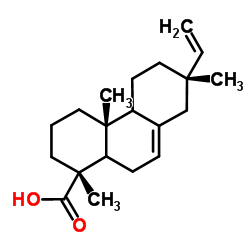(5ξ,9ξ,13α)-Pimara-7,15-dien-18-oic acid

(5ξ,9ξ,13α)-Pimara-7,15-dien-18-oic acid structure
|
Common Name | (5ξ,9ξ,13α)-Pimara-7,15-dien-18-oic acid | ||
|---|---|---|---|---|
| CAS Number | 5835-26-7 | Molecular Weight | 302.451 | |
| Density | 1.1±0.1 g/cm3 | Boiling Point | 416.7±45.0 °C at 760 mmHg | |
| Molecular Formula | C20H30O2 | Melting Point | 160° | |
| MSDS | USA | Flash Point | 200.0±23.4 °C | |
| Symbol |

GHS09 |
Signal Word | Warning | |
|
Phloroglucinols from anti-microbial deposit-resins of Australian stingless bees (Tetragonula carbonaria).
Phytother Res. 29(1) , 48-58, (2015) Stingless bees accumulate deposits of plant resins that are mixed with beeswax to produce propolis. Previous studies have reported anti-microbial constituents of stingless bee (Tetragonula carbonaria) propolis from East Australia, but several components remai... |
|
|
Spontaneous and evoked contractions are regulated by PKC-mediated signaling in detrusor smooth muscle: involvement of BK channels.
Am. J. Physiol. Renal Physiol. 304(5) , F451-62, (2013) Protein kinase C (PKC) and large conductance Ca(2+)-activated potassium channels (BK) are downregulated in the detrusor smooth muscle (DSM) in partial bladder outlet obstruction (PBOO). DSM from these bladders display increased spontaneous activity. This stud... |
|
|
[Analysis of main chemical composition in hydrogenated rosin from Zhuzhou].
Se Pu 19(1) , 78-81, (2001) The acid fraction, the main part of the hydrogenated rosin produced by Zhuzhou Forest Chemicals Plant of China, was separated from neutral fraction by modified DEAE-Sephadex ion exchange chromatography and analyzed with GC-MS-DS technique by using DB-5 capill... |
|
|
Influence of band 3 protein absence and skeletal structures on amphiphile- and Ca(2+)-induced shape alterations in erythrocytes: a study with lamprey (Lampetra fluviatilis), trout (Onchorhynchus mykiss) and human erythrocytes.
Biochim. Biophys. Acta 1466(1-2) , 125-38, (2000) Amphiphiles which induce either spiculated (echinocytic) or invaginated (stomatocytic) shapes in human erythrocytes, and ionophore A23187 plus Ca(2+), were studied for their capacity to induce shape alterations, vesiculation and hemolysis in the morphological... |
|
|
Highly-oxygenated isopimarane-type diterpenes from Orthosiphon stamineus of Indonesia and their nitric oxide inhibitory activity.
Chem. Pharm. Bull. 51(3) , 268-75, (2003) From the methanolic extract of Indonesian Orthosiphon stamineus, nine new highly-oxygenated isopimarane-type diterpenes [7-O-deacetylorthosiphol B (1), 6-hydroxyorthosiphol B (2), 3-O-deacetylorthosiphol I (3), 2-O-deacetylorthosiphol J (4), siphonols A-E (5-... |
|
|
Pseudomonas reinekei sp. nov., Pseudomonas moorei sp. nov. and Pseudomonas mohnii sp. nov., novel species capable of degrading chlorosalicylates or isopimaric acid.
Int. J. Syst. Evol. Microbiol. 57(Pt 5) , 923-31, (2007) Three bacterial strains, designated MT1(T), RW10(T) and IpA-2(T), had been isolated previously for their ability to degrade chlorosalicylates or isopimaric acid. 16S rRNA gene sequence analysis demonstrated that these bacteria are related to species of the ge... |
|
|
Enzyme cytochemical responses of mussels (Mytilus edulis) to resin acid constituents of pulp mill effluents.
Bull. Environ. Contam. Toxicol. 63(4) , 430-7, (1999)
|
|
|
New beyerane and isopimarane diterpenoids from Rhizophora mucronata.
J. Asian Nat. Prod. Res. 4(1) , 53-61, (2002) Chemical examination of the ethyl acetate extract of the roots of Rhizophora mucronata collected from Mangalore Coast resulted in the isolation of three more new diterpenoids, rhizophorins C-E (1-3) in addition to the two, rhizophorin A, (6R,11S,13S)-6,11,13-... |
|
|
Molecular basis of pimarane compounds as novel activators of large-conductance Ca(2+)-activated K(+) channel alpha-subunit.
Mol. Pharmacol. 62 , 836-846, (2002) Effects of pimaric acid (PiMA) and eight closely related compounds on large-conductance K(+) (BK) channels were examined using human embryonic kidney (HEK) 293 cells, in which either the alpha subunit of BK channel (HEKBKalpha) or both alpha and beta1 (HEKBKa... |
|
|
Evolution of conifer diterpene synthases: diterpene resin acid biosynthesis in lodgepole pine and jack pine involves monofunctional and bifunctional diterpene synthases.
Plant Physiol. 161(2) , 600-16, (2013) Diterpene resin acids (DRAs) are major components of pine (Pinus spp.) oleoresin. They play critical roles in conifer defense against insects and pathogens and as a renewable resource for industrial bioproducts. The core structures of DRAs are formed in secon... |